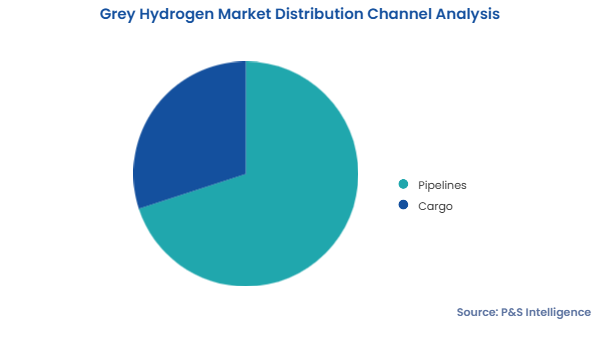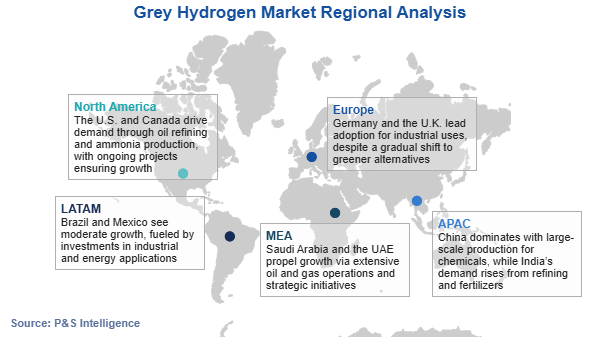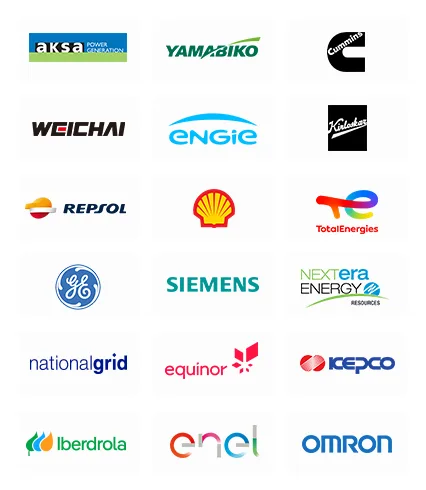Grey Hydrogen Market Analysis
Explore In-Depth Grey Hydrogen Market Analysis, Covering Detailed Segmentation and Geographical Insights for the Period of 2019 to 2032
Report Code: 13289
Explore In-Depth Grey Hydrogen Market Analysis, Covering Detailed Segmentation and Geographical Insights for the Period of 2019 to 2032
Pipelines constitute the larger category in the market as they are generally the cheapest and most-efficient way of transporting gaseous and liquid fuels over long distances. Pipelines also provide a steady and reliable supply of hydrogen, which is an important factor in industrial applications. Europe already has 1,600 km of hydrogen pipelines, and another 3,000-km-long pipeline, known as the SoutH2 Corridor, is being laid to connect Germany, Austria, North Africa, and Italy. Moreover, by 2040, Europe aims for a 40,000-km hydrogen pipeline network.
Cargo is the faster-growing category in the market, at a CAGR of 2% during the forecast period. This is largely because of the growing demand for hydrogen in areas that do not have an established pipeline infrastructure. Additionally, cargo solutions are flexible in transporting hydrogen to remote regions, especially trucks. As more hydrogen is used in locations far from the pipeline network, emerging markets, and smaller industrial plans, cargo methods, such as tanker trains, trucks, and ships and cylinders, are gaining popularity.

The distribution channels analyzed here are:
Petroleum refining has the largest revenue share in the market. Hydrogen is widely utilized in refineries for hydrocracking and hydrotreating operations to remove impurities from crude oil, including sulfur, and improve the quality of refined fuels. In 2020, the International Maritime Organization revised its previous limit of 3.5% sulfur mass by mass for in ship fuel oil to 0.5 m/m. The consumption of grey hydrogen in petroleum refining has been supported by the easy availability of natural gas, the feedstock used to produce it, and the voluminous demand for refined petroleum products worldwide.
Transportation is the fastest-growing category in the market due to the increase in the popularity of hydrogen-powered trucks, buses, and trains. Hydrogen fuel cells provide relatively more-efficient and less-polluting energy for long-distance and heavy-duty transportation when compared to traditional fossil fuels. Government policies and incentives also promote the transition to hydrogen-driven vehicles. This will create opportunities for hydrogen refueling infrastructure and expand the adoption of grey hydrogen across the transport industry. Encouraged by these efforts, BMW and Toyota are collaborating to launch FCEVs by 2028. Honda, Hyundai, and many more OEMs also offer these automobiles or are working to launch them within this decade.
The end uses analyzed here are:

The geographical breakdown of the market is as follows:
Want a report tailored exactly to your business need?
Request Customization

Working with P&S Intelligence and their team was an absolute pleasure – their awareness of timelines and commitment to value greatly contributed to our project's success. Eagerly anticipating future collaborations.
McKinsey & Company
IndiaOur insights into the minutest levels of the markets, including the latest trends and competitive landscape, give you all the answers you need to take your business to new heights
We take a cautious approach to protecting your personal and confidential information. Trust is the strongest bond that connects us and our clients, and trust we build by complying with all international and domestic data protection and privacy laws
Customize the Report to Align with Your Business Objectives
Request the Free Sample Pages